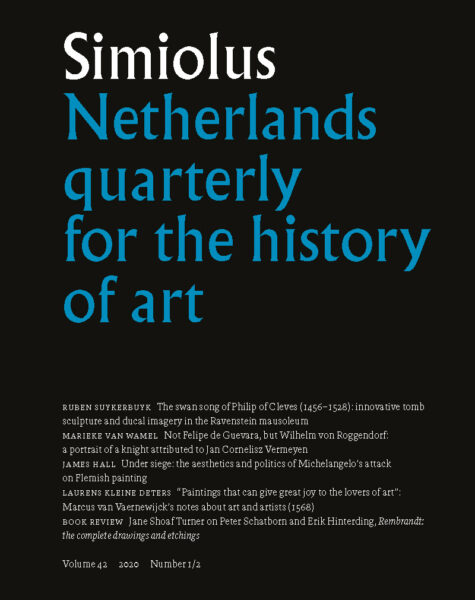
Filedt Kok 2017
“Hieronymus Bosch after 500 years: exhibitions and publications in 2016” (Jan Piet Filedt Kok) 2017
[in: Simiolus – Netherlands quarterly for the history of art, vol. 39 (2017), nr. 1/2, pp. 111-124]
In a properly balanced and well-informed way, this article offers an overview of the major exhibitions and books which were organised and published in 2016, on the occasion of the memorial of Bosch’s death 500 years ago (in 1516). First the author compares the exhibitions in the Noordbrabants Museum (’s-Hertogenbosch) and in the Prado (Madrid) and their respective catalogues to each other. Just like the previous two Bosch exhibitions (’s-Hertogenbosch 1967 and Rotterdam 2001), the exhibitions in ’s-Hertogenbosch and Madrid were structured thematically, but they focused less on the Bosch followers and all the more on the autograph works. Filedt Kok writes the following about the two catalogues:
The exhibition catalogues are very dissimilar. The one for ’s-Hertogenbosch is a well-written summation of the views of the compilers, which are spelled out in greater detail and more closely argued in the BRCP’s Catalogue raisonné. The Madrid catalogue is a more attractive and lavish affair and contains several fascinating essays, but because most of the entries are written by the curators of the lending museums, their quality and scope is uneven, and the same is true of the information they contain. Some of the authors appear to know little about the findings of the BRCP’s research, while others take the opportunity to contest them, sometime vehemently. [p. 114]
Next, the two volumes published by the BRCP in 2016 (the Catalogue raisonné and the Technical studies) are discussed, with special mention of the accompanying website boschproject.org. Filedt Kok’s opinion on the two BRCP volumes:
The catalogue entries are lengthy, in contrast to the short essays, and they too are mostly a pleasure to read, with superb illustrations of many details. Despite the clear layout and generally very readable text, the attention paid to the different aspects of each painting is rather uneven and was clearly guided by the interest of the various authors. Skillful editing, for which there was evidently no time, could certainly have resulted in greater concision and a more balanced approach, and might also have helped to temper the polemical tone, particularly in the opposition to the views of Fritz Koreny. The Technical studies are a useful supplement to the Catalogue raisonné, mainly because of their abundant illustrations, but one wonders whether the systematic incorporation of all the technical details would not have been better off on a website, particularly the descriptions of condition, most of which have been made redundant by the recent restorations. [p. 114]
Filedt Kok also mentions a number of Bosch books which were published in or shortly before 2016: Koreny (2012), Büttner (2012), Schwartz (2016), Fischer (2013), and Holger-Borchert (2016a en 2016b).
The rest of this article offers a concise overview of the current state of Bosch research. First, the author focuses on the archival documents and the patrons. Filedt Kok does not seem to have a high opinion of Koldeweij’s theory that the St John on Patmos and St John the Baptist panels (Berlin and Madrid) were meant for the altarpiece of the Brotherhood of Our Lady, and Koldeweij’s suggestion that Hippolyte de Berthoz was the commissioner of the Vienna Last Judgement and the Lisbon St Anthony is called ‘hypothetical’. He also points out that Silva Maroto (curator of the Prado exhibition) seems to consider the paintings in Madrid autograph, because they are mentioned among the works acquired by Philip II, adding that few experts agree with her.
The section ‘Attributions on the basis of technical examination’ praises the work of the BRCP team and the facilities offered by the website boschproject.org. Peter Klein’s dendrochronological research has yielded interesting information, but its results should be handled with caution. More words are spent on the problems linked to the examination of underdrawings and style in the works attributed to Bosch, on the role of Bosch’s workshop, and on the followers of Bosch. Filedt Kok shares his opinions on the major part of the works discussed here, suggesting a lot but arguing rather off-handedly. The same is true for the sections on the autograph Bosch oeuvre and the drawings. Filedt Kok feels that Koreny’s insights concerning the drawings are sharper than those of the BRCP team, and yet he does not wholly agree with the Viennese Bosch author. The last section on Bosch’s iconography is more concise, with short references to the monographs by Falkenburg (2011) and Higgs Strickland (2016) and to the catalogues of exhibitions in Rotterdam (2015), St Louis (2015), and Hamburg (2016).
Filedt Kok concludes:
The scientific research carried out by the BRCP and others, the conservation of a number of core paintings, and the scholarly preparations for both exhibitions have added vastly to our knowledge of Bosch’s work, and his oeuvre is now far better defined. The interpretation of all this new material will take time, and there will continue to be differences of opinion and interpretation, so it is an illusion to think that there will ever be full agreement. [pp. 123-124]
Desiderata for future Bosch research are the publication of the research results by the Prado, the Vienna Akademie, and the Ghent museum and a continued study of the works by Bosch followers.
Filedt Kok’s interesting overview is very welcome and attests to the author’s familiarity with the world of Bosch exegesis but is not complete. For example, the Bosch congress in the JBAC in April 2016 and De Vrij 2012 are not mentioned. Other publications, such as the collected lectures of the JBAC congress, Koerner 2016, and Vandenbroeck 2017 were probably not available yet when this contribution was written.
[explicit 18 May 2022]